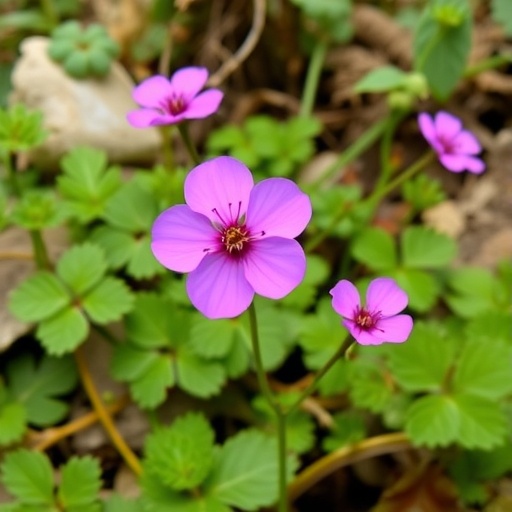
In a significant advancement for botany, a recent study published in Discover Plants has shed light on the genus Geranium, particularly focusing on newly identified species from the remote Pangi Valley of Himachal Pradesh, India. This research contributes invaluable data to our understanding of plant diversity and the ecological significance of this less-explored region. The findings have the potential to influence not only academic research but also conservation efforts in the Himalayas, an area that is home to unique flora and fauna.
Researchers P. Dey and P. Agnihotri undertook an extensive field survey of the Pangi Valley, ensuring rigorous methodology that combined both observational techniques and molecular analysis. This comprehensive approach allowed them to not only catalog existing species but also to identify previously undocumented specimens. Such methodological rigor is crucial in botany, as it often determines the accuracy of species classification and our broader understanding of plant ecology.
One of the core objectives of this study was to revisit the taxonomic classification of Geranium species within the geographical confines of Pangi Valley. The genus, known for its garden appeal and medicinal properties, holds significant importance for both biodiversity and cultural practices among local communities. The study highlights that many of the identified species demonstrate unique adaptations to their mountainous environment, showcasing nature’s ingenuity in survival strategies.
During their study, Dey and Agnihotri recorded numerous specimens belonging to the Geranium genus, some of which exhibit characteristics that could categorize them as new species. This discovery has profound implications, as it emphasizes the necessity for further exploration of lesser-known habitats. The researchers argue that biodiversity hotspots like Pangi Valley warrant focused attention, given their potential to reveal undiscovered species that contribute to our planet’s ecological balance.
The importance of preserving such ecosystems cannot be overstated. With increasing anthropogenic pressures threatening the biodiversity of many natural habitats, the documentation of species like those in the Geranium genus is essential. This research may serve as a critical benchmarking point for future conservation strategies, aiming to protect not only the plants but also the intricate web of life they support in these fragile ecosystems.
Another noteworthy aspect of the study is its contribution to the understanding of plant evolution in high-altitude environments. The adaptations observed in the Geranium species from Pangi Valley raise questions about evolutionary processes and how climate influences phenotypic variations. This research opens up avenues for further ecological studies that can delve into the genetic and environmental factors that account for such diversity.
Moreover, the study illustrates the relevance of botanical research to understanding climate change effects. As temperatures rise and patterns of precipitation change, studying how endemic species adapt can provide insights into broader ecological shifts. The findings here could aid conservationists in devising strategies to help these plants cope with the emerging challenges posed by climate change.
In summary, the research conducted by Dey and Agnihotri demonstrates the need for an ongoing investigation into the flora of regions that are often overlooked in botanical studies. The revelations surrounding Geranium species not only enhance the scientific community’s knowledge but also emphasize the collaborative effort needed to ensure biodiversity conservation. It illustrates how local ecologies can be better understood through careful study and respect for indigenous knowledge.
In concluding remarks, this research plays a vital role in raising awareness about the ecological wealth housed in the Himalayas, urging policymakers and conservationists to prioritize these regions in their agendas. The ongoing exploration of Geranium and other lesser-known plant genera is crucial for paving the way toward sustainable management and preservation of biodiversity.
As the global community grapples with the impact of environmental changes, studies like these highlight the importance of ecological hubs where research can lead to actionable insights. By illuminating the uncharted territories, botanists like Dey and Agnihotri contribute significantly to not only academic literature but to the collective understanding of our natural world. Their work in Pangi Valley represents a clarion call for future research endeavors aimed at uncovering the mysteries of our planet’s biodiversity.
In essence, the study serves as a reminder that much of the world’s floral diversity remains undiscovered. The enduring relationship between humans and nature can only thrive through the pursuit of knowledge, and scientific endeavors of this nature foster a deeper appreciation for the marvels of plant life. As we continue to uncover the secrets held within our biospheres, one can only hope that these invaluable treasures are cherished and protected for generations to come, ensuring that the wonders of the natural world are preserved within the tapestry of human experience.
Subject of Research: Exploration of the genus Geranium in Pangi Valley, Himachal Pradesh, India.
Article Title: Revisiting the genus Geranium along with new records from Pangi Valley, Himachal Pradesh, India.
Article References:
Dey, P., Agnihotri, P. Revisiting the genus Geranium alongwith new records from Pangi Valley, Himachal Pradesh, India.
Discov. Plants 2, 254 (2025). https://doi.org/10.1007/s44372-025-00329-7
Image Credits: AI Generated
DOI: 10.1007/s44372-025-00329-7
Keywords: Geranium, Pangi Valley, biodiversity, plant taxonomy, conservation, Himalayas, plant adaptation, climate change, ecological studies, flora, phytogeography, species documentation, high-altitude ecosystems.
Tags: botanical field survey methodologiesbotany research advancementsconservation efforts in plant diversitycultural practices related to plantsecological significance of HimalayasGeranium diversity in Himachal Pradeshmedicinal properties of Geraniumnewly identified plant speciesobservational techniques in botanyPangi Valley plant speciestaxonomic classification of Geraniumunique flora and fauna of Himalayas





